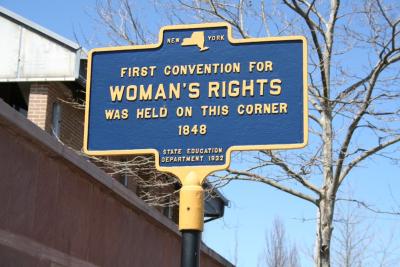
Women in the U.S. have only had the right to vote for just over 100 years, and women of color gained the right to vote even more recently. This year, the U.S. Election Assistance Commission (EAC) honored Women’s History Month by exploring some of the key moments that led to women’s suffrage and the ratification of the 19th Amendment.
While the 19th Amendment was not ratified until 1920, the fight for woman suffrage began over 70 years earlier at the first Women’s Rights Convention in 1848. Earlier this month, EAC Chairwoman Christy McCormick had the opportunity to talk with Donald Stanko, the Lead Park Ranger for the History of Women’s Rights National Historical Park in Seneca Falls, New York, where the first Women’s Rights Convention took place, to learn more about the suffrage movement and the museum.
Mr. Stanko was joined by Susan Philpott, a Park Ranger at the Belmont-Paul Women’s Equality National Monument in Washington, D.C., a house that served as the headquarters of the National Woman's Party for over 90 years and was designated a national monument in 2016. The house also served as a hub of civic engagement that led to the ratification of the 19th Amendment.
Key to the success of the suffrage movement was the ability to build upon existing social change tactics. “You can kind of see that model from the Abolitionist movement moving into the Women's rights movement,” said Mr. Stanko. “Women are going to be getting their rights by making it happen through the political process, through the amendment process, through all those other things. You kind of see a lot of that origin of the future movement.”
Voting is an integral aspect of civic engagement, and the discussion between EAC Chairwoman McCormick, Mr. Stanko, and Ms. Philpott provides insights from the past that we can draw from as we work to engage voters today. One of the key themes that emerged was that no matter the issue, there are multiple paths forward to creating progress. It is also important to understand that change takes time and like the women who helped achieved the right to vote, it can take generations to achieve further change.
“Sometimes when we tell the story, it sounds like someone held a sign or someone held a march and then equality shows up,” said Ms. Philpott. “That is never the way it happens because people work and struggle… Sometimes, like Elizabeth Cady Stanton and Susan B. Anthony, you do the work your whole life and you don’t get to see it. You have to teach the next generation to take it up.”
Chairwoman McCormick added, “This conversation is another example of why it is so important to participate in the political process. This is a crucial right – for all eligible voters – that must not be taken for granted.”
If you would like to get more involved, you can sign up to become a poll worker and find your local election office by visiting helpamericavote.gov.

